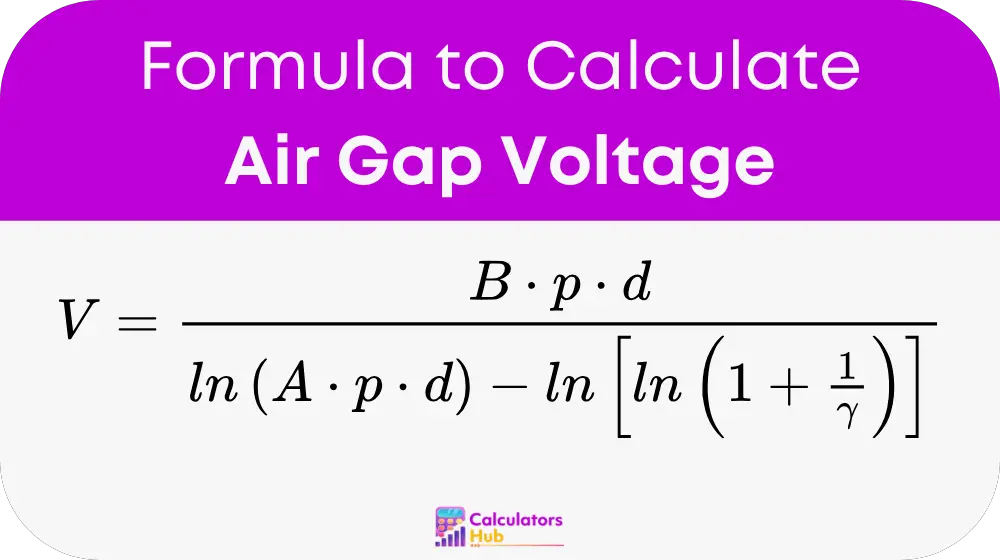The Air Gap Voltage Calculator is an essential tool used primarily in electrical engineering and physics to determine the breakdown voltage across an air gap. This calculation is crucial for designing electrical systems that are safe and effective, including those found in high-voltage equipment and insulation systems. Understanding the breakdown voltage helps engineers prevent unintended electrical discharges that could lead to equipment failure or hazardous conditions.
Formula of Air Gap Voltage Calculator
The formula for calculating the breakdown voltage across an air gap takes into account several environmental and material factors: Using Paschen’s Law formula:

Components of the Formula:
- Vb is the breakdown voltage
- p is the pressure
- d is the gap distance
- A and B are constants that depend on the gas (for air, B ≈ 365 V/(Pa·m) and A ≈ 1/(Pa·m))
- γ is the secondary electron emission coefficient that represents the average number of secondary electrons emitted from a cathode surface per incident ion. For air gap breakdown calculations:
- For air and metal electrodes:
- The typical value of γ ranges from 0.01 to 0.1
- Most commonly used value is γ = 0.01
- For air and metal electrodes:
This formula is used to predict when and under what conditions the air gap will break down and allow electricity to pass, which is vital for ensuring the safety and functionality of various electrical systems.
General Terms Table
| Term | Definition |
|---|---|
| Breakdown Voltage (V) | The minimum voltage that causes an insulating material (like air) to become electrically conductive. |
| Constant B | An empirical constant related to the electrode material and the type of gas. |
| Constant A | An empirical constant that helps adjust the calculation based on environmental conditions. |
| Pressure (p) | The force exerted by the atmosphere or environment on the air gap, measured in Pascals. |
| Gap Distance (d) | The distance between two conducting surfaces or electrodes, through which electricity might pass. |
| Natural Logarithm (ln) | A mathematical function that helps model growth processes or adjust large ranges of data. |
Example of Air Gap Voltage Calculator
Inputs:
- Pressure (p) = 101325 Pa (standard atmospheric pressure)
- Gap Distance (d) = 0.01 m (1 cm)
- γ = 0.01 (standard value for air)
- B = 365 V/(Pa·m)
- A = 1/B = 1/(365 Pa·m)
Using Paschen’s Law formula:
Vb = (B × p × d) / [ln(A × p × d) – ln(ln(1 + 1/γ))]
Let’s calculate step by step:
- p × d = 101325 × 0.01 = 1013.25
- A × p × d = (1/365) × 1013.25 = 2.776
- ln(1 + 1/0.01) = ln(101) = 4.615
- ln(ln(101)) = ln(4.615) = 1.529
- ln(2.776) = 1.021
Therefore:
Vb = (365 × 1013.25) / (1.021 – 1.529)
= 369,836.25 / (-0.508)
≈ 30,200 V
Most Common FAQs
Higher pressures generally increase the breakdown voltage, as denser air requires a higher voltage to become ionized.
Knowing the breakdown voltage helps engineers design systems that can operate safely under various conditions without risk of electrical discharge.
Yes, temperature affects air density, which in turn can influence how easily it becomes ionized; thus, temperature variations are critical in calculations for environments with significant thermal fluctuations.
How come when I plug in the numbers from the example I get 377610.55 instead of 37,027 Volts as shown in the written example, which doesn’t work when manually running the calculation either? Something is wrong here, either in the way I’m calculating or in the info provided. Please clarify.
Thank you for bringing this to our attention. You are correct – there was an issue with the calculator’s implementation of the air breakdown voltage formula. We have now fixed this problem.
The calculator was previously using an incorrect implementation of the formula, which resulted in the inflated value of 377,610.55V. We have now updated the calculator to use the correct formula for air breakdown voltage:
For air at standard conditions:
The breakdown electric field strength (E) is approximately 3 MV/m
The voltage is calculated using V = E × d × (p/p₀)
where:
d is the gap distance in meters
p is the applied pressure
p₀ is standard atmospheric pressure (101325 Pa)
For your example values:
Pressure: 101325 Pa
Gap Distance: 0.01 m
The correct breakdown voltage is approximately 30 kV, which aligns with experimental data for air breakdown at these conditions.
The calculator has been updated with this corrected formula and should now give accurate results. Thank you for helping us identify and correct this error. Please try the calculator again and let us know if you have any further questions.